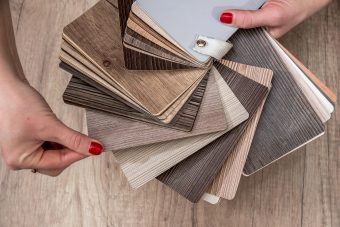April 8, 2020

There’s no denying just how popular vinyl and luxury vinyl flooring has become over the years. It has become the go-to flooring for most Aussie homeowners for its durability, versatility and its ability to mimic the genuine good looks of timber flooring.
Not only is it stain resistant, it’s also waterproof, making it an ideal flooring choice for areas that are prone to moisture and spills.
However, a study conducted in 2015, revealed that additional chemicals were used during the manufacturing process of vinyl flooring, one of which was a PVC softener, Phthalates.
Phthalates (PVC softener) was an organic chemical used to make vinyl flooring more flexible and made up a large portion (up to 60%) of the final product. Phthalates can be found in hundreds of common products used in homes, hospitals and businesses including furniture, cables, building construction and more.
Prolonged exposure to the chemical can lead to health risks in humans including respiratory and reproductive health issues.
Toxicity levels of vinyl flooring was once a major concern dating back to the study which was conducted in 2015. It’s now 2020 and most floor manufacturers have eliminated the use of this chemical and now provide ‘phthalates-free’ vinyl flooring.
When in doubt, you can offset these concerns by making sure you purchase vinyl flooring from a qualified manufacturer who employs high quality materials and resources. It’s always best to consult your rep.
Due to the materials used in the production process of vinyl, it will sometimes emit various levels of VOCs into the air for a short amount of time after installation. These toxic chemicals can be harmful to air quality of the immediate environment it’s installed in and may cause respiratory problems over time.
That said, the level of VOCs released is related to the quality of material used in production and the amount of time that has passed since the initial installation. Again, if you’re concerned about these effects, always make sure to purchase vinyl flooring from a trusted manufacturer who uses high quality materials. Then make sure to ventilate the space for several days or weeks after install.
Nowadays, thanks to an increase in safety regulations and advancements in technology, most vinyl manufacturers have employed techniques to produce vinyl planks and tiles with very low-VOCs and majority of it is now phthalate-free.
Carpet remains one of the most popular flooring choices for most Perth homes. However, it’s not completely safe, with many carpeting polluting household air quality with VOCs such as formaldehyde, benzene and stain repellents. That’s not to say you should be avoiding all types of carpet flooring. View eco-friendly carpets (link to Jupps)
Is carpet right for you? View our carpet guide.
Out of most floor types, ceramic tiling is generally one of the safest non-toxic flooring options that is very easy to clean and maintain. The only question to ask about is the safety of the grout and ventilation processes used during installation, as well as any other materials that may cause toxic fumes.
For those with allergies, hardwood flooring is one of the best options. The hard surface allows for dust and other allergens to be easily vacuumed and removed. Just be weary of the finisher being used, making sure to go with a non-toxic sealant.
Linoleum is made from all-natural and biodegradable materials, largely composed of linseed oil, a naturally occurring substance that has been extracted from flax seeds, mixed in with other sustainable materials including, cork dust, wood flour and rosin.
Unlike vinyl flooring, laminate at the core is made from 99% wood byproducts fused with resins. In terms of layers, it has a similar construct to vinyl where there is a base underlay, core layer, design and wear layer, as well as a polyurethane coating to seal it off. The issue with laminate flooring lies within the adhesives being used. Chemicals such as formaldehyde, isocyanates (carcinogen), and aluminium oxide can be found in most adhesives used.
Still unsure which is the safest flooring for your home and family? Speak to one of our friendly experts here at Jupps Floor Coverings Perth for some advice on choosing the best floor type suited to the demands of your home and lifestyle.
Check out our other blogs which discuss the pros and cons of other flooring options.